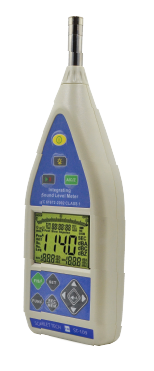

ST-109 Class 1 Sound Level Meter
Online Free Tutorial
Scarlet provides free training modules that users can easily learn ST-109 in few minutes. The online training courses include basic features, data logging functions, and software introduction. Find more in our youtube channel.
ST-109 Tutorial
ST-109 Class 1 Sound Level Meter


Specification
- Evaluation of environmental noise
- Measurements of noise at workplaces
- Design of cost-effective noise control plans
- Assessment of product noise
| Item | Description |
| USB interface | Yes |
| Micro SD card | Up to 32G |
| Bargraph display | Yes |
| Display | 3 1/2 digit backlit LCD display, maximum reading of 2000 |
| Display refresh rate | 1 time/ per second |
| Applicable specifications | IEC 61672-1 : 2002 Class1, ANSI S1.4 Type 1, CNS NO.7129 Type 1, JJG-188-2002 Class1 |
| Microphone | 1/2" pre-polarized condenser microphone build in preamplifier: -26 +/- 2dB (50mV/Pa), Fequency range: 10 Hz~20 kHz, heat noise : <28 dN(A) |
| Measurement items | SPL, Leq, SEL,Max, Min |
| Measurement range | 30dB ~ 130dB (A), 35dB ~ 130dB (C), 40dB ~ 130dB (Z) |
| Dynamic Range | 100 dB |
| Integrate Time Setup | randomly,10s, 1m, 5m, 10m, 30m, 1h, 2h, 4h, 8h, 16h, 24h or set in a given range |
| Max. peak C sound level | measurement 70~133 dB |
| Time weighting | Fast, Slow, Impulse, Peak |
| Frequency weighting | A/C/Z |
| Frequency Range | 10Hz~20KHz |
| DC output | 2Vdc/130dB |
| AC output | 2Vrms/130dB |
| Battery Life | 30 hours |
| Battery | LR6 1.5V*4 Alkaline batteries |
| Dimensions | 285(L) x 90(W) x 39(H) mm |
| Weight | 550g (including Batteries); 2.5Kg (including package) |
- IEC 61672-1 : 2002 Class1
- ANSI S1.4 Type 1
- CNS NO.7129 Type 1
- JJG-188-2002 Class1
A Class 1 Sound Level Meter is a noise measurement instrument that meets the requirements of IEC 61672-1:2002 (or an equivalent such as BS EN 61672-1:2003) to Class 1 performance.
This standard specifies two levels of performance, Class 1 and Class 2, with Class 1 being effectively more accurate. Within the standard are a set of performance criteria that an instrument must meet and each of these has a tolerance associated with it. The tolerances for Class 1 are tighter than for Class 2. For example, at the reference frequency of 1kHz, the tolerance limits for Class 1 are +/- 1.9dB and for Class 2 the tolerance is +/- 2.2dB.
A simple sound level meter that meets the standard may only provide Sound Pressure measurements whereas a much more sophisticated instrument may provide for the measurement of Sound Pressure, Leq and Peak Sound Pressure.For example, the Noise at Work Regulations which are used in the UK requires, as a minimum, the measurement of LAeq and LCPeak.
Whether you need a Class 1 or a Class 2 sound level meter will depend largely upon the application that you will be using the instrument for.
If you are working to an environmental noise standard then this may specify that the instrument should be Class 1. For example, ISO 20906:2009 “Unattended monitoring of aircraft sound in the vicinity of airports” states that “..shall conform to the electroacoustical performance specifications of IEC 61672-1 for a class 1 sound level meter.”
The Class 1 sound level meter tend to measure lower levels due the sensitivity of the microphone capsule. This is particularly relevant for environmental noise surveys where low noise levels are being measured. Finally, you may choose Type 1 for important legal applications as the evidence from the more accurate meter may be more convincing, even when the regulations do not demand it. Class 1 sound level meter is preferred for the design of cost-effective noise controls.
There are many very low cost (under $200) devices masquerading as sound level meters but so far none of these have been proven to meet their sales clams. Thus their use may risk hearing damage because of measurement errors.
Class 1 sound level meter offers greater accuracy and is considered more realiable if a noise case goes to court. The usual cost of Class 1 sound level meter may range from $1500 to $4000 depended on capacities. We are convinced to have best price guarantee on our Class 1 Sound Level Meter ST-109. For further quotation, please contact us.
Our Clients











